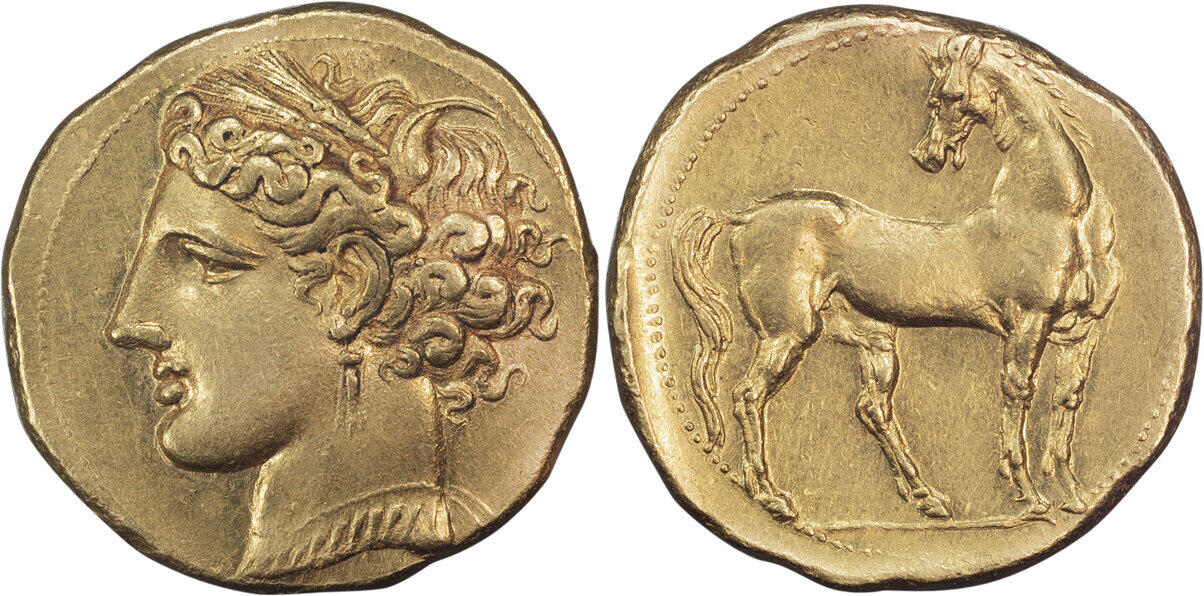H 328 - Carthage, gold, tridrachms (265-255 BCE)
From SILVER
265 BCE - 255 BCE Gold 15,787 kg
Description
| ObverseInscription or printing placed on the obverse.: | Head of Tanit l., wearing wreath of grain ears, triple pendant earring, and necklace with hanging pendants |
| ReverseInscription or printing placed on the reverse.: | Unbridled horse standing r. on exergual line, head turned back |
Mint and issuing power
| MintIdentifies the place of manufacture or issue of a numismatic object.: | Carthage | Ancient regionAncient region.: | Zeugitana | Modern countryModern country: Tunisia | AuthorityIdentifies the issuing power. The authority can be "pretended" when the name or the portrait of X is on the coin but he/she was not the issuing power. It can also be "uncertain" when there is no mention of X on the coin but he/she was the issuing power according to the historical sources: | Carthaginian Empire |
Chronology
| FromIdentifies the initial date in a range assigned in a numismatic context. | 265 BCE | toIdentifies the final date in a range assigned in a numismatic context.. | 255 BCE | PeriodTime period of the numismatic object.: Hellenistic 323-30 BC |
Physical description
| MetalThe physical material (usually metal) from which an object is made.: | Gold |
Median weightMedian of the weights of numismatic objects (in grams). in grams | 12.45 | DenominationTerm indicating the value of a numismatic object. Examples: tetradrachm, chalkous, denarius.: | tridrachm |
StandardStandard.: |
Image

H328 Carthage tridrachm Tanit and horse.jpeg [1]
References
| Die study referencePublication of the study: | Jenkins - Lewis 19631Jenkins - Lewis 1963, (série IX). | ||
| Coin series referenceReference to coin series study: | RQEMH2RQEMH, n° 328 | ||
Obverse dies distribution
| FrequencyFrequency of specimen in distribution. ᵖ | Number of obversesNumber of obverse dies. ᵖ (o) | % (o) | Number of coinsNumber of coins. (n) | % (n) | Die nameName(s) of the die(s). |
| 1 | 1 | 16.67 | 1 | 2.44 | 379 |
| 4 | 1 | 16.67 | 4 | 9.76 | 391 |
| 5 | 1 | 16.67 | 5 | 12.2 | 377 |
| 8 | 1 | 16.67 | 8 | 19.51 | 384 |
| 9 | 1 | 16.67 | 9 | 21.95 | 380 |
| 14 | 1 | 16.67 | 14 | 34.15 | 393 |
| Total | 6 of 6 | 100.02 | 41 of 41 | 100.01 |
Reverse dies distribution
no distribution is available
Quantification
| Number of obversesNumber of obverse dies. ᵖ (o) | 6 | Number of singletons (o1)The number of singleton coins. ᵖ | 1 |
| Number of reverse diesNumber of reverse dies. (r) | 24 | Number of coinsNumber of coins. (n) | 41 |
| Coins per obverse dieNumber of coins per obverse die. (n/o) | 6.83 | Coins per reverse dieNumber of coins per reverse die. (n/r) | 1.71 |
| Reverse per obverse ratioRatio of obverse dies divided by reverse dies. (r/o) | 4 | Percentage of singletons (o1)number of coins (n) divided by the number of singletons (o1) ᵖ | 16.67 % |
| Original number of dies (O) (Carter 1983 formula)The estimation of the number of coins according to Carter 1983 ᵖ | 6.34 | Coins struck if 20,000 as average productivity per dieCoins made if the average productivity for obverses (according to Carter) is 20,000. ᵖ | 126,800 |
| Original number of dies (O) (Esty 2011 formula)The estimation of the number of coins according to the singleton formula in Esty 2011 ᵖ (O) | 7.03 | Survival rate if 20,000 as average productivity per dieSurvival rate if average productivity is 20,000. ᵖ | 0.00032 |
| Coverage (o = % of O) (Esty 1984 formula)Esty 1984 - coverage (% of O) ᵖ (o = % of O) | 97.56% | Die productivity if survival rate 1/2,000Average productivity if survival rate is 1/2,000. ᵖ | 12,933.75 |
| Weight of silver (in kg) if 20,000 coins per die (O = Carter formula)Carter 1983 * Median weight * 20000 (*10 if gold or electrum) ᵖ | 15,787 kg <br /> 15,787 kg | Die productivity if survival rate 1/5,000Average productivity if survival rate is 1/5,000. ᵖ | 32,334.38 |
Remarks